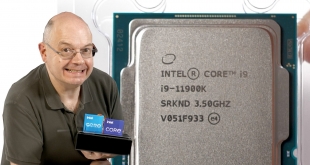
11th Gen Rocket Lake CPUs mark the first shift in architecture for Intel's desktop line-up since Skylake debuted all the way back in 2015. Here we the assess the flagship part, the 8-core and 16-thread Intel Core i9-11900K. We know this SKU offers two fewer cores than the i9-10900K, and we also know expectations for these processors have not been high since the first early reviews went live earlier this month.
Timestamps
- 00:00 Start
- 00:15 Summarising
- 03:03 A quick look at the system / Adaptive Boost
- 06:48 A bit of a mess really
- 08:55 A look at performance graphs
- 10:54 CPU Power Draw and Temperatures
- 11:43 Gaming Performance
- 12:45 Handbrake tests
- 13:17 Pricing discussion / woes
- 15:00 Should you use Adaptive Boost?
- 16:37 Why has Intel even bothered to launch Rocket Lake?
- 18:30 Adaptive boost has killed overclocking
Before diving into the meat of this review, we recommend you cast your eye over some previous content on Intel Rocket Lake, including Leo Says Ep. 58 and Leo Says Ep.59. That will lay the groundwork for this review, with discussion on what Rocket Lake is, Intel's Adaptive Boost technology, the Z590 chipset and more.
i9-11900K Specification:
- Socket: 1200
- Base Frequency: 3.50GHz
- Intel Smart Cache: 16M
- Cores / Threads: 8/16
- Memory speed support: 2933-3600MHz
- Intel Single Core Turbo frequency: 5.1GHz
- Intel Turbo Boost Max 3.0 Single core frequency: 5.2GHz
- Intel Thermal Velocity Boost single / all core turbo frequency: 4.8GHz – 5.3GHz
- Intel ALL core turbo frequency: 4.7GHz
- Max PCI-Express Lanes: 20
- PCI Gen 4.0 Support: YES
- Onboard Graphics: YES Intel UHD Graphics 750
- Integrated memory controller: Yes – Dual Channel
- TDP: 125W
- Intel SIPP: YES
- Intel vPro Technology: YES
- ISM: YES
- Intel Optane memory: YES
- Warranty: 3yr
 KitGuru KitGuru.net – Tech News | Hardware News | Hardware Reviews | IOS | Mobile | Gaming | Graphics Cards
KitGuru KitGuru.net – Tech News | Hardware News | Hardware Reviews | IOS | Mobile | Gaming | Graphics Cards


